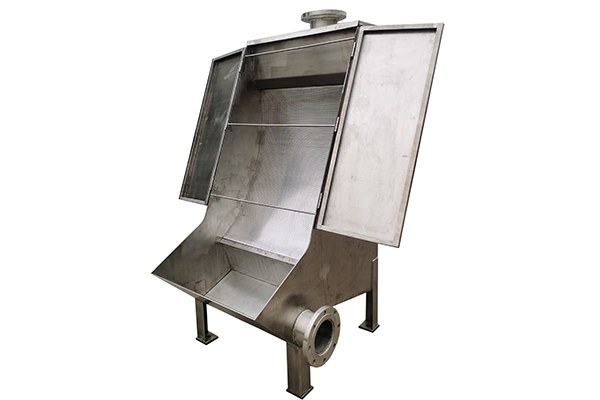Tel: +86 311 8595 5658 E-mail: admin@yuanlvfilter.com
✔ Removes large and fine solids before they enter the downstream processes
✔ Apply in municipal and industrial wastewater treatment systems
✔ Known for its static wedge wire design and low-maintenance operation
A Hydrosieve Screen (also known as a static wedge wire screen, parabolic screen, or sidehill screen) is a non-mechanical screening device used in wastewater treatment systems. It is built with a curved or parabolic stainless steel wedge wire panel that allows water to flow through precisely engineered slots while retaining solid particles.
Unlike rotary drum screens or bar screens, the hydrosieve has no moving parts. It relies entirely on gravity and hydraulic energy to separate solids from liquids. This makes it both energy-efficient and highly durable, requiring minimal maintenance.
• Curved wedge wire screen surface for high screening efficiency.
• Stainless steel construction to resist corrosion in wastewater environments.
• Static operation: no motors, gears, or complex mechanical systems.
• Customizable slot sizes (typically 0.25 mm to 3.0 mm) depending on the required level of filtration.
• Compact design suitable for retrofitting into existing treatment facilities.
The working principle is simple yet highly effective. Wastewater is evenly distributed across the parabolic wedge wire screen surface. As water passes through the slots, suspended solids are retained and slide down due to gravity. The filtered liquid continues into the wastewater treatment system, while screened solids are collected for disposal or further processing.

1. Municipal Wastewater Treatment
Primary screening of sewage influent.
Removal of plastics, rags, paper, and organic matter.
Pretreatment before sedimentation tanks and biological processes.
2. Industrial Wastewater Treatment
• Food and Beverage: separation of fruit peels, vegetable pulp, and organic residues.
• Dairy Industry: removal of fats, proteins, and fibrous particles.
• Breweries: separation of hops, spent grains, and yeast solids.
• Textile Industry: capturing lint, fibers, and dye-laden solids.
• Pulp and Paper Mills: fiber recovery and wastewater screening.
• Chemical & Pharmaceutical Plants: pretreatment of complex effluents.
3. Sludge Thickening and Recovery
Used as a pre-thickening device for sludge management.
Efficiently reduces water content in sludge before further processing.
4. Aquaculture and Agriculture
Screening of fish farm effluents.
Separation of solids in irrigation water recycling systems.
We are experts in Hydrosieve screens and provide solutions and equipment for wastewater treatment systems.
When selecting a hydrosieve screen wastewater treatment system, consider the following factors:
✔ Wastewater Type: Municipal, food processing, dairy, brewery, textile, or chemical.
✔ Flow Rate: Hydrosieve screens are available in different capacities to match plant requirements.
✔ Slot Size: Smaller slots (0.25–1.0 mm) for fine solids; larger slots (1.0–3.0 mm) for coarse separation.
✔ Material of Construction: Preferably stainless steel (304, 316, or duplex grades) for durability.
✔ Installation Space: Compact models for space-limited facilities.
✔ Supplier Expertise: Choose a manufacturer with experience in custom wedge wire solutions.
Q1: What is the main purpose of a hydrosieve screen in wastewater treatment?
A hydrosieve screen is designed to separate suspended solids from wastewater in the pretreatment stage, reducing the load on downstream processes.
Q2: What industries benefit most from hydrosieve screens?
Industries such as municipal sewage, food processing, dairy, brewing, pulp and paper, textile, and chemical manufacturing commonly use hydrosieve screens.
Q3: What materials are hydrosieve screens made of?
Most hydrosieve screens are constructed from stainless steel wedge wire to resist corrosion and provide long service life.
Q4: How fine can a hydrosieve screen filter?
Typical slot sizes range from 0.25 mm to 3.0 mm, depending on the required level of screening.
Q5: Do hydrosieve screens require electricity?
No. Hydrosieve screens operate entirely by gravity flow and require no power for screening.
Q6: How do you maintain a hydrosieve screen?
Maintenance is minimal - typically involving periodic cleaning with water jets or brushes to prevent clogging.
Q7: What is the difference between a hydrosieve screen and a rotary drum screen?
Rotary drum screens use mechanical rotation and motors, while hydrosieve screens are static and energy-free, making them more cost-effective for many applications.
Q8: Can hydrosieve screens handle high flow rates?
Yes, hydrosieve screens are available in a range of sizes and can be scaled up to handle municipal-scale wastewater flows.
Q9: Are hydrosieve screens suitable for sludge thickening?
Yes. Hydrosieve screens are often used as a sludge pre-thickening solution, reducing water content before further treatment.
Q10: How long does a hydrosieve screen last?
With proper care, a high-quality stainless steel hydrosieve screen can last 10-15 years or more.